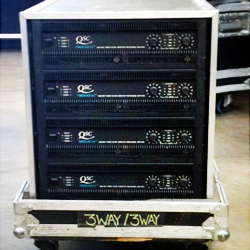
Q.) If you take a 500W amp and turn it down 3 dB, then it’s a 250W amp, right?
A.) No, it’s still a 500W amp. It just takes 3 dB more input signal to reach that 500W full power level. For example, if the amp’s input sensitivity (the voltage at which it reaches full rated power for a given load) is 1V, then turning the gain controls down 3 dB means it will instead take a signal level of I.4V to reach full power.
Q.) Should I always run my amps turned up to full gain?
A.) No, that’s why your amps have gain controls in the first place—so you can adjust the gain. Some amps, particularly very high-powered models that were designed to match the input sensitivity of lower-powered models, have a lot of gain—60 to 80 times or more. That could be a lot more gain than you actually need, too. That’s because the amp also amplifies not only the signal, but also all of the hum and noise from upstream in the system.
Thus, with such an amp turned up full, you might find that the hum and noise is too high in the system, particularly if you’ve reduced the gain of the crossover, mixer, or other devices in the system to compensate for the amp’s high gain. You could then improve the overall signal-to-noise ratio by turning down the amp gains and boosting the input signal accordingly, as long as you avoid clipping the upstream devices.
On the other hand, there are two reasons for keeping the amps turned up all the way:
1.) It’s easily repeatable without making errors; and
2.) You just might happen to need all that gain.
At any rate, it’s always easier to deal with having more gain than you need than it is having not enough.
Q.) I’m considering an amp purchase, but its input sensitivity spec is over 2V. How will I ever drive the thing to full power?
A.) Fear not. Any line-level pro audio gear should be able to put out at least + 18 dBu (6.16V RMS) before clipping, and many can put out signals as high as +24 dBu (12.3V RMS). So hitting 2V or more on peaks is not a problem unless you have your gain structure severely out of whack.
Q.) Can I use constant-gain amps and constant-sensitivity amps together in the same system?
A.) Absolutely, as long as you calculate your gain and power needs correctly. But you need to do that anyway. Before we go further, let’s clarify the terms here: “constant gain” means a group of amps have the same maximum gain despite their possibly different power points; the advantage of this is you can design your system around rules like “1V in = Xwatts at 8 ohms, or 2Xwatts at 4 ohms, or 4Xwatts at 2 ohms” throughout.
“Constant sensitivity” refers to a group of amps that have the same or very similar input sensitivity, regardless of their power points. Knowing the sensitivity of an amp is useful for setting limiters and for avoiding clipping the amp, but knowing the gain will allow you to calculate a good initial setup on your system.
